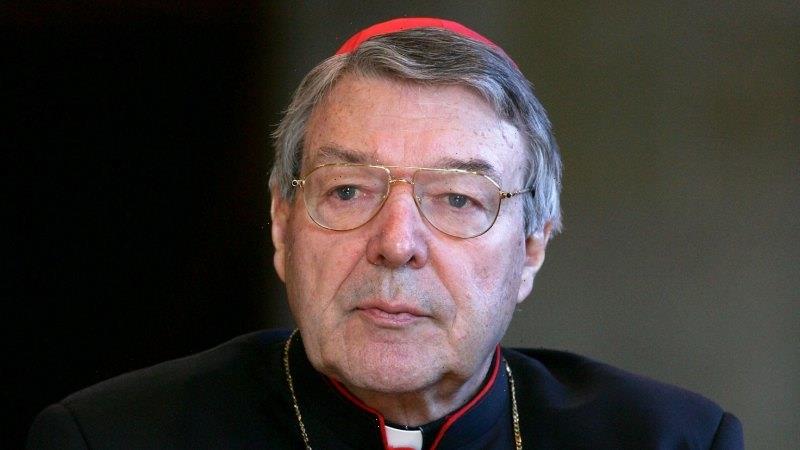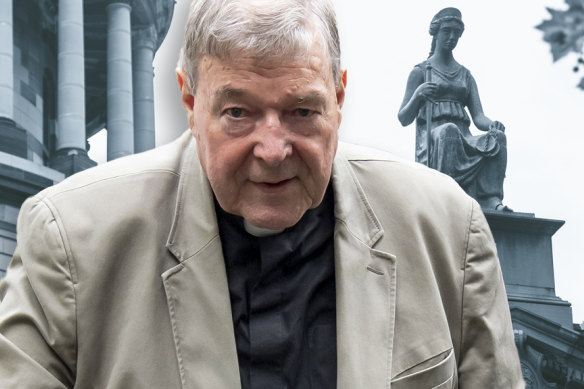George Pell, contempt and a courtroom: How the public is missing out
I am no longer surprised by how often I hear people say they get their news from Twitter, Facebook or TikTok.
One of the challenges and duties of journalism is to feed into the maelstrom of dubious, opinion-laced or downright misleading words with information that has been verified by reliable means and published in a way people will want to read and understand.
The courts are an important source of this information.
News organisations and journalists faced contempt of court charges over their coverage of a guilty verdict against Cardinal George Pell – which was later overturned.Credit:
For decades journalists have been working with courts to make the justice system more open and transparent by freeing up access to information: documents, transcripts, judgments and the like. A lot of good things have happened in that time.
Now it seems to me this is turning back to some extent. Perhaps it’s the courts’ response to a less certain, more chaotic information environment; maybe they are holding more tightly to information to exercise more control over it.
At The Age we are challenging a newish practice under the rules of the Victorian Supreme Court which means the prothonotary – the court’s chief administrative officer – is now denying access to documents we once could obtain freely.
In the case we are contesting, the victim/plaintiff and her lawyers want the documents released, but the court has denied this, saying that releasing them might put the court itself in breach of prohibitions on publishing information under the Family Violence Protection Act and the Family Law Act. These are acts that already cover the media – we must obey them – so we could not publish unlawful information anyway. Nevertheless, we are being denied the ability to publish even what we could, legally, do.
The Federal Court has also just announced, without proper consultation, an amendment to its rules to restrict the availability of documents such as statements of claim until milestones in litigation are reached – a process that could take months or never happen at all.
We’re talking here about cases of crucial public interest brought by the regulators of banks, companies and super funds, among other things. Where once these documents were freely available, now we must apply for them. We’ll only receive them at the judge’s discretion after the parties – some of them very well-funded – have had a chance to object, delay and obfuscate.
Then, when a case finally reaches the courtroom, the media are too often confronted with suppression orders, which are issued at a rate of several a day in the Victorian courts.
The worst breakdown of relations between the media and the courts that I can remember was over this issue. Between 2019 and 2021, dozens of journalists in Victoria were prosecuted for breaching a suppression order in the George Pell sexual abuse case.
I was one of them.
When Pell was found guilty in the County Court of sexually abusing two choirboys, not a word of it could be reported initially because Justice Peter Kidd, the court’s chief judge, had suppressed the entire proceeding.
Legal academic Jeremy Gans has written that in big trials, such as Pell’s, the general public wants “to know every detail of the evidence and events”, and these occasions provoke “wider and very important discussions about how well the courts do their jobs”.
“High-profile cases put the justice system itself on trial, and rightly so,” he wrote.
The suppression order meant we never got that broader discussion in the Pell case. The reason for it was that there was to be a subsequent trial of Pell on unrelated charges. Australian media couldn’t publish details of this crucial matter because 12 potential future jurors might see it.
But when the guilty verdict was handed down, that silence was quickly breached. Not by the Australian media, but on the internet. Several international outlets published the key detail: Pell, the Vatican’s number three man, was guilty.
Less than 24 hours later, the words “George Pell” were the number one searched term on Twitter in Australia with 13,300 tweets.
“George Pell has been convicted,” wrote one tweeter. “Australian media are under suppression orders so you have to Google international sites.”
“I am not media,” said another one, “so I will sing it from the top of my lungs.”
“I cannot find a single MSM [mainstream media] article about it,” said a fourth: “Why is this significant news … being concealed?”
On Reddit, Google search, Facebook, the subject of Pell’s guilt was red hot and the conspiracy theories were growing.
We felt – I felt – The Age needed to address this torrent of speculation. So, guided by legal advice from two separate lawyers, we produced a carefully cryptic story saying, a “very high-profile figure” had been convicted of an unnamed charge and we couldn’t say more because of a suppression order.
Other media did a similar thing in their different ways.
The judge was furious. The media, he said, seemed to believe “it’s OK to print everything and anything apart from the name”.
“A number of very important people in the media are facing, if found guilty, the prospect of imprisonment and indeed substantial imprisonment,” he said.
Director of Public Prosecutions Kerri Judd told the judge the maximum penalty for these breaches was “about five years [imprisonment]” adding that he should leave the matter with her.
The jailing of journalists for doing their jobs is no small matter anywhere in the world. But in Victoria, the prosecutions followed by the dozen. Something like 100 threatening letters were sent out.
Meanwhile, shortly after Pell’s guilty finding, the DPP dropped the second trial for lack of evidence. Pell appealed the first conviction to the Court of Appeal and lost, and then to the High Court where, in April 2020 he was acquitted of all charges and soon left the country.
Still our contempt case dragged on.
When it was finally heard against 15 journalists and organisations, it did not go well for us. Sniffing the wind, the companies pleaded guilty to protect the individual journalists. Fourteen months after Pell’s High Court acquittal, The Age was convicted and fined $450,000, among a total $1.1 million in fines for the media more broadly, plus the prosecution’s costs.
There is a pattern here: courts restricting the release of all information just in case a media organisation might do something wrong; courts suppressing entire cases (or in the Witness J matter in the ACT Supreme Court, hearing it entirely behind closed doors); courts restricting information about upcoming civil cases lest it cause some unspecified damage to parties involved.
There is a strong principle in the legal system of open justice. But these, I think, are signs that some courts and judges have lost trust in the media and the public, and perhaps in the openness principle entirely.
The real danger is that it hits outlets like us hardest. You can suppress The Age, sue us and prosecute us for contempt, but not one of the people who sent the 13,300 tweets about George Pell was prosecuted. Nor was any international outlet for breaching the suppression order – none of which had professional reporters in the court throughout the case, understanding its nuances, as we did.
All this might be an attempt to keep control in a chaotic environment, but in my view it’s precisely because of the easy availability of misinformation that the media needs better access to good information, so we can get the truth out there.
There are positives here.
The move by some judges and courts to livestream their judgments is brilliant, as is the timely provision of transcripts to reporters during trials.
Judge Kidd’s decision to livestream his sentencing of Pell in March 2019 was terrific: he explained the legal process convincingly, and I’d be prepared to bet, nipped in the bud any criticism of the length of the sentence or the reasons behind it.
It was a testament to what an open court can achieve.
I just think there should be more of it.
- This is my last editor’s note. I decided after eight years editing the work of others that I want to return to reporting and writing. Tune in for new editor Patrick Elligett’s first note next week. And thank you. It’s been a blast.
The Age’s new editor Patrick Elligett will send a newsletter to subscribers each week. Sign up to receive his Note from the Editor.
Most Viewed in National
From our partners
Source: Read Full Article


